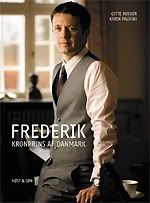 “Frederik: Kronprins af Danmark” is the newest biography about the Danish royals. Where the unofficial biography about Marie Cavallier came before the wedding – just in time for the Danes to get to know their new princess (and the publisher to make quick money on it, if we’re being cynical about it…) – this latest endeavour was published on the occasion of Crown Prince Frederik’s 40th birthday. It is written by Karin Palshøj og Gitte Redder, the same two journalists who wrote the biography of Crown Princess Mary.
“Frederik: Kronprins af Danmark” is the newest biography about the Danish royals. Where the unofficial biography about Marie Cavallier came before the wedding – just in time for the Danes to get to know their new princess (and the publisher to make quick money on it, if we’re being cynical about it…) – this latest endeavour was published on the occasion of Crown Prince Frederik’s 40th birthday. It is written by Karin Palshøj og Gitte Redder, the same two journalists who wrote the biography of Crown Princess Mary.
The fact that this is an official biography is shown by the fact that not only is Crown Prince Frederik talking to the authors, his brother, his close friends, his head of security, his former colleagues, and so on, are also doing it – and they’re doing it by name. A few notables are missing – the Queen, the Prince Consort, some royal cousins… but that’s just nitpicking.
The book is divided into several chapters, which does rather match the periods in Frederik’s life. Among others we have the chapters “Frederik’s Royal House,” “The little prince,” – incidentally, his childhood, if you were wondering – “From Boy to Man,” “Frogman 210,” “the Diplomat,” “Greenlandic Gold,” “Love,” “Father,” and “An athlete.” There’s also a chapter on Frederik’s interest in modern art, and how he hid his education in this interest from his parents, a chapter on his relatives, and also one with his reflections as to where he sees himself and Mary when they, once upon a time, will become King and Queen of Denmark.
Some of the revelations we get aren’t really all that new to us – but the angle on them is interesting nevertheless. Others are more fresh, and we haven’t considered them in that light before. Prince Joachim has an interesting comparison, wherein he holds his brother up against Crown Prince Haakon of Norway – and compares their outlook on their position, from the point where they became Crown Princes. Crown Prince Frederik became aware of his position at a vulnerable time, and didn’t really have any sparring partners to discuss it with – and at the same time he became more cut off from his own brother who was to inherit Schackenborg.
While Haakon, on the other hand, was older when he became the Crown Prince. To me, he often seems like the more focused of the two, and more confident about his destiny. It sort of feels like Frederik is only now beginning to come to terms with who he is, and who he is going to be. They’re roughly at the same place in their lives, family and education-wise; but there is a marked difference in their ages.
There are also the fun revelations, such as Frederik’s approach to having more children:
“We would like another child. And I could well enough be inspired to go on, until we had an entire football team. A couple of years ago, I would probably have asked, how do you administer four children, who’re heading off in 4 different directions? But today, I know families with four and five children, who’re managing it perfectly well.”
For those who’re unfamiliar with European football – a team consist of eleven players. I wonder if he’ll get Mary to join in on that idea? 😉
One thing I found fascinating was his views on patronages. It is revealed he has a personal interest in all the patronages he has. Of course, I did suspect something like that, but this, put together with his art interest, does explain why he’s the patron of an art gallery/museum.
He also has some interesting viewpoints on his position as a candidate for the IOC. Personally I think that the whole debacle is an issue because it happened at the same time as people began debating whether or not he should boycot the Beijing Olympics, and so the two are linked in people’s minds. Like with the attendance question, he’s careful to point out that he asks permission from the cabinet/prime minister, before he takes on any organizations that might be controversial.
All in all, it was an entertaining couple of hours. The language is a bit flowery, but it beats being bored to death by dry prose.
Just a quick warning: The book is thick, at close to 400 pages, and there are some interesting pictures; however, it is chiefly text, and unless you read Danish, it is not worth buying it solely for the pictures.